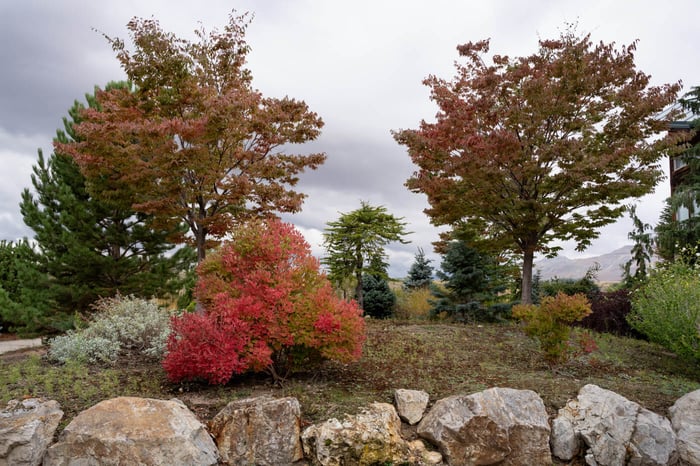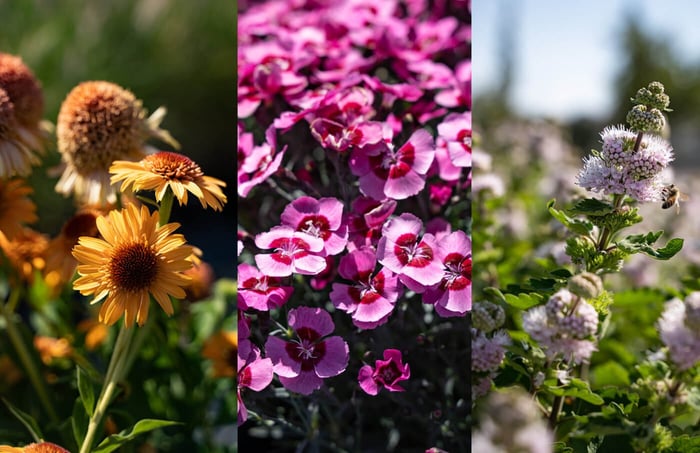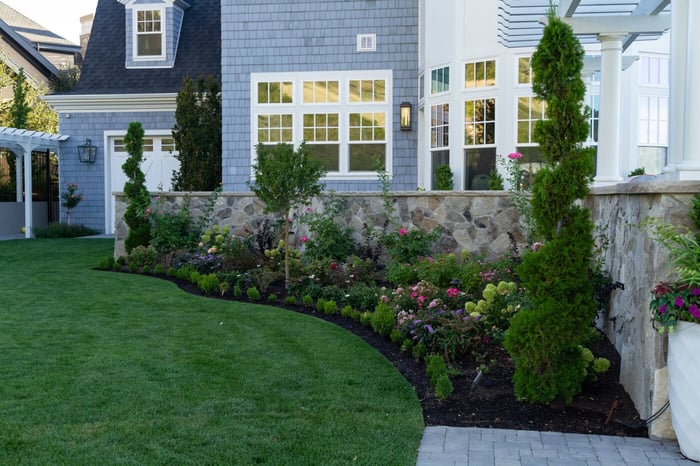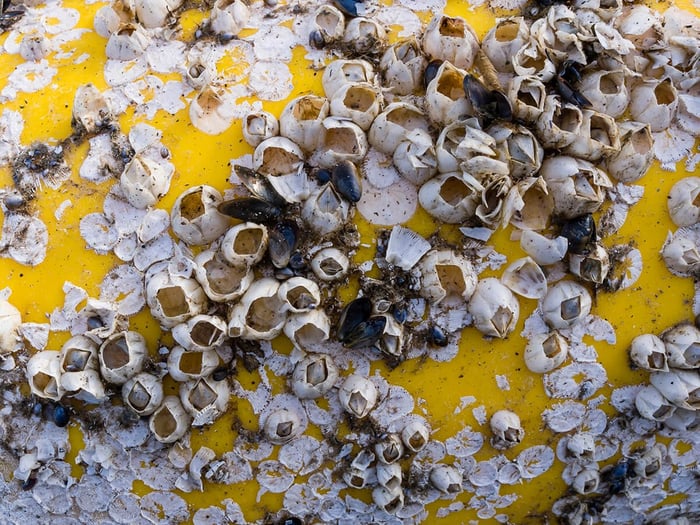Trees and shrubs are key structural elements in any garden. They establish the basic shape of the garden bed and bring essential visual weight to your landscape. Some garden beds are quite large and lend themselves well to large shade trees. Other beds are too small for large specimens. Large trees can outgrow their space and create loads of extra work in the form of pruning or even tree removal a few years down the road. It’s best to plant trees and shrubs that will fit your space when they’re mature. Plants that reach a certain size and stay there make it much easier to maintain your garden. But how do you choose the best deciduous and conifer trees for your space?
In general, landscape trees are divided into two separate categories: Deciduous trees—trees that lose their leaves in the fall, and Conifers—evergreen trees with needles. (There are exceptions including broadleaf evergreens and even deciduous conifers, but we’ll stick to these basic distinctions for the purposes of this discussion.) Both deciduous and conifer trees can hold a special place in any landscape. Today we’ll discuss several deciduous trees that will work nicely in smaller garden beds. This list is, by no means, exhaustive, and it’s in no particular order. These are simply trees that we like to use in small to medium sized garden beds.
Zelkova trees are wonderful deciduous trees for Utah landscapes. They are available in various shapes and sizes and most of them tend to grow in a vase shape. For smaller garden beds we suggest ‘City Sprite’ or ‘Musashino.’ City Sprite is the smallest of the two options, reaching a height of 20-25’ and a spread of around 20’. Musashino will also spread to around 20’ wide, but it can grow as high as 40’. Both trees grow dense foliage for thick shade, considering their size. Both offer vibrant yellow fall color, but the Musashino tends to add some orange and copper to its coloring in the fall. They prefer full sun and don’t require a lot of water once they’re established.
Typically, Honeylocust trees grow rather large, providing wonderful dappled shade for your landscape. That’s great unless you have a small space to fill. For those smaller areas, we recommend ‘Sunburst’ Honeylocust. It’s a fast-growing, irregular, spreading tree selected for its golden-yellow new foliage. The leaves gradually change to bright green, then back to yellow again in the fall, so it will hold your attention throughout the growing season. It’s also fruitless, so it won’t drop seed pods. It will reach a height of around 30’ with a spread of around 25’, and it doesn’t need a lot of water once it’s established.
These stunning deciduous trees offer amazing pink-to-purple blossoms in the spring that cover the branches and even extend onto the trunk. They are available in several sizes and shapes with varying leaf colors. Some have green leaves that turn yellow in the fall. Others have burgundy leaves that turn green during the hottest point of summer and then turn yellow in the fall. Still others feature multi-colored leaves! Any one of them can work in a smaller garden bed, so check them out and get creative! For small spaces we recommend ‘Merlot,’ ‘Flame Thrower,’ ‘The Rising Sun,’ ‘Black Pearl,’ ‘Hearts of Gold,’ ‘Covey’ Lavender Twist, ‘Ruby Falls,’ or ‘Golden Falls’.
Japanese Tree Lilac or Peking Lilac Tree
Lilac trees are an amazing addition to your Utah landscape. Unlike typical lilac bushes, lilac trees bloom in the early summer, and their bloom season lasts just a little longer than the typical lilac bush. The flowers range from white to primrose yellow, depending on the cultivar, and they will reach anywhere from 15-25’ tall and 12-15’ wide. Fill your yard with delightful fragrance with this stunning flowering tree. Some varieties even offer exfoliating bark for year-round interest. Cultivars that we carry include: ‘Ivory Silk’ Japanese Tree Lilac, ‘Summer Storm’ Japanese Tree Lilac, ‘Bailnce’ Snowdance™ Japanese Tree Lilac, 'Zhong Zhiming' Beijing Gold™ Peking Lilac, and 'Morton' China Snow™ Peking Lilac Tree.
Crataegus ambigua, Russian Hawthorn is a nearly perfect small deciduous tree with gorgeous bark, foliage, and flowers. Its glistening red fruit in fall is beloved by birds, so you’ll have almost no mess to clean up. It grows well in most soils, requires just a moderate amount of water once it’s established, and is hardy to zone 4. It does have some thorns, however, so you probably won't have too many children trying to climb it.
Hackberry trees can get large, but Prairie Sentinel maintains a narrow growth habit, reaching a height of 40’ but only spreading to around 12’. It’s ideal for narrow city streets in the toughest climates. It offers great adaptability to heat and drought, and it’s disease free. Fall foliage is yellow, and it’s hardy to zone 4.
Many of you will argue that Serviceberries are shrubs and not trees. You would be right. Serviceberries are available as small to large shrubs, but there are some that grow as single or multi-trunk trees as well. Their spring blossoms are amazing, and their fall color is impressive. On top of that, they produce delicious fruit that tends to ripen in June. Their fruit is the closest thing to a blueberry that you can grow here in Utah. They’re delicious. If you choose not to harvest the fruit, don’t worry. The birds will eat so much of it, you’ll have very little to clean up. Almost any serviceberry tree or shrub will work nicely in your smaller garden beds. If you’re looking for a tree form, specifically, we recommend ‘Snowcloud,’ ‘Rogers’ Lustre, and ‘Autumn Brilliance’.
Typically, you wouldn’t think of an oak as a suitable tree for small spaces, but there are some columnar varieties that actually can work for you. One of those is ‘Kindred Spirit’ Columnar English Oak. It has matte foliage and a tight narrow form with a yellow to brown fall color, and it’s resistant to mildew. It is hardy to zone 4, and will reach 30’ tall with a spread of only 6’. If you have a little more space, you might consider ‘Skinny Genes’ Columnar English Oak. It will reach 40’ tall with a spread of only 10’. Its leaves turn yellow before they drop in the fall.
If you aren’t looking for something as formal as ‘Kindred Spirit’ or ’Skinny Genes’, you may be interested in the Gambel Scrub Oak. This is native to the mountains here in Utah and it will reach 20-25’ tall with a spread of 12-15’. It will deliver multiple colors in fall ranging from yellow to red. And, of course, it will provide several acorns in the fall.
Arguably the best ornamental flowering trees for Utah’s growing conditions are crabapples. Today’s crabapple trees are not like the ones you grew up with. The fruits tend to be smaller and they’re more persistent, which means they’ll stay on your tree into the winter months providing food for birds. You won’t have the clean up that you used to have decades ago. Their blossoms are stunning in the spring and their fall color is brilliant. There are dozens of wonderful crabapple trees to choose from. We love ‘Show Time,’ ‘Red Barron,’ ‘Indian Magic,’ ‘Raspberry Spear,’ ‘Ivory Spear,’ ‘Royal Raindrops,’ ‘Spring Snow,’ and ‘Prairie Rose,’ just to name a few.
Carpinus betulus 'Frans Fontaine' European Hornbeam
Hornbeams are fantastic deciduous trees with a stunning growth habit, but they can get quite large. However, ‘Frans Fontaine’ European Hornbeam is much more narrow. They’re a great underused tree for planting strips and small gardens. Upright in habit, this hornbeam has small ovate, ridged leaves that emerge a soft medium green and turn yellow in the fall. They’ll reach up to 40’ tall and 12-15’ wide.
Many people are worried about planting Elm trees because we’re so familiar with the weed-like Siberian Elm. On top of that, many of you may be familiar with Dutch Elm Disease, which can wreak havoc on elm trees. However, Ulmus ‘Frontier’ Elm is an American elm with an upright-pyramidal growth habit and proven superior resistance to Dutch elm disease. It’s a beautiful tree with smooth, gray-green bark and remarkable fall foliage colors of red-to-purple. Genetically, this tree is an ideal combination for our climate and growing conditions. It’s a fast-growing tree, hardy to zone 4, and will reach a height of 30’ with a spread of 25’
Ulmus propinqua 'JFS-Bieberich' Emerald Sunshine® Elm
This is another amazing elm tree that will thrive in your Small-to-medium-sized Utah landscape. It features handsome, deeply corrugated leaves that emerge coppery-bronze and mature to glossy green. Fall color is vibrant yellow. It’s an ideal shade tree—Insect resistant, tolerant of heat and drought, fast-growing, tough and adaptable. It’s hardy to zone 5, and will reach a height of 40’ with a spread of 25’.
Smaller Maple Trees Suited For our Conditions
Maple trees can struggle in Utah. They need iron to be strong, and although our soil is iron-rich, it’s also highly alkaline, heavy in saline and other dissolved solids including calcium, magnesium, and sulfur. These elements inhibit a maple tree’s ability to absorb iron, causing iron chlorosis—yellowing of leaves, weak branches, and often a slow, drawn-out death.
On top of that, Maples (particularly young maples and Japanese Maples) have thin bark that can sometimes lead to winter damage. If a maple is planted in an extreme hot spot in your landscape, (against the south side of your house) it can warm up just enough during a sunny winter day to awaken the cambium layer beneath its thin bark. That living layer will begin to draw up moisture only to freeze at night, causing the cambium to erupt and crack the bark. This damage will lead to an early death as well. (For better success, plant your Japanese maples on the north or north-east side of your house.) That said, there are several maples that can thrive here, so today we’ll focus on a few smaller cultivars that can grace your yard.
Acer ginnala 'Flame' Amur Maple
This small, deciduous maple is hardy to zone 2 and will reach a height of 20’ with a spread of 20’. Green summer foliage turns bright red in the fall. Flowers are very fragrant, appearing in the early spring. It’s grown as a single trunk or multi-stem clump, and it’s perfectly suited for almost any Utah landscape.
Acer ginnala 'Ruby Slippers' Amur Maple
Very similar to ‘Flame’ Amur, ‘Ruby Slippers’ Amur Maple is a single-trunk tree with a more uniform canopy. Fragrant white-green flowers appear in spring and turn to samaras that become bright red in early summer. Foliage turns scarlet in the fall. It’s hardy to zone 3 and will reach a height and width of 20’.
Acer tataricum 'GarAnn' PP15023 HOTWINGS® Tatarian Maple
Hotwings is also similar to the Amur Maple varieties, but it grows a little taller and narrower, making it an ideal tree for smaller garden beds. This small tree was selected for its stronger branching structure, improved fall color, and brighter red samaras. A Colorado selection, this cultivar also shows more tolerance to alkaline soils, so it’s a winner all the way around. Hotwings is hardy to zone 3 and will reach 20-25’ tall with a spread of 12-15’. Its vibrant green leaves change to a multitude of colors in the fall from yellow to orange, and red.
Acer griseum 'JFS KW22AGRI' Copper Rocket™ Columnar Paperbark Maple
Paperbark Maples are prized for their beautiful curling, peeling bark. The contrast of the lighter brown exterior to the rich cinnamon interior means this tree will hold your interest year round. Copper Rocket retains a nice columnar form, reaching a height of 20-25’ with a spread of 10-12’. Its leaves emerge copper-green, turning green during the summer months and changing to orange in the fall. It’s hardy to zone 4 and prefers full sun to partial shade, 3 to 6 or more hours of sun each day.
Beech Trees
Beech trees are some of our favorite deciduous trees here at the nursery. They’re stately trees that need very little babysitting. Many beech trees will outgrow today’s smaller yards, but there are a few that are ideal for your smaller garden beds.
Fagus sylvatica 'Dawyck Purple' Columnar Purple Beech
This tall, extremely columnar tree features rich purple, often nearly black, foliage all season long, yet you can still distinguish its red fall tones. It’s excellent for color, articulation or as a tall screen. This beech prefers rich soil and regular moisture. It’s the ideal size for home landscape use. It’s hardy to zone 4 and will reach a height of 50’ or more with a spread of just 10’. It thrives in full sun to part shade.
Fagus sylvatica 'Red Obelisk' Columnar Purple Beech
This deciduous, very upright, columnar tree features foliage that is bronze-red-purple and slightly dissected. It’s perfect for a tight spot or a vertical accent in the garden. The serrated pointy leaves turn an outstanding coppery bronze in the fall. Slightly more narrow in form with redder leaf color compared to Dawyck Purple. It’s hardy to zone 4 and will reach 40’ tall with a spread of only 8’. Prefers full sun to part shade.
Fagus sylvatica 'Fastigiata' Columnar Green Beech
This outstanding columnar beech features bright golden leaves in the spring that fade to a nice lush yellow-green in the summer. Fall color is gold and tan. Its dense habit is great for shade and privacy. It’s hardy to zone 4 and will reach a height of 30’ with a spread of 10’ in full sun to part shade.
Fagus sylvatica 'Tricolor' 'Roseomarginata' Beech
Triclor Beech is one of the most popular beech trees for smaller spaces here in Utah. Its color is outstanding and it makes a wonderful conversation piece. As it’s getting established, you may want to protect it from the hottest afternoon sun to help prevent leaf burn and increase its water intake during the hottest weeks of summer. Foliage emerges purple and pink in the spring, changes to dark bronze-green with pink to white margins in the summer, and bronze-gold in the fall. It’s an absolutely stunning, deciduous, upright tree, hardy to zone 4. It will reach a height of 30’ with a spread of 20’ and prefers full sun to partial shade.
Prunus serrulata 'Kwanzan' Flowering Cherry
This upright, vase-shaped to spreading flowering cherry has a profusion of deep pink, double flowers with a mid-spring bloom. Dark green foliage turns to orange-red fall color. Cherry trees have beautiful reddish-brown bark that contrasts against their deep green leaves during the summer, and its leaves will turn brilliant red in fall. It’s hardy to zone 4 and will reach a height of 20-25’ with a spread of 20’. Prefers full sun exposure.
Prunus x 'Snowfozam' Snow Fountain® Weeping Flowering Cherry
This is a deciduous, weeping cherry with white flowers in early spring. Dark green leaves appear after the flowers and turn a nice combination of orange and yellow in the fall. Like all weeping cherry trees, the reason this tree weeps is because it has been grafted partway up the trunk. The mature height of this tree depends on the graft height. Because this is a grafted tree, you’ll need to watch closely for young branches that sprout straight up, especially if they start from the trunk below the graft. These branches are native to the grafted root/trunk stock and they will need to be pruned off immediately. Otherwise, you will be left with an odd combination of upright, less-ornamental branches on top of a tree with a weeping skirt of blossoms near the base. This tree is hardy to zone 4 and will reach a height of 12-15’ with a spread of 8’. Prefers full sun exposure.


























